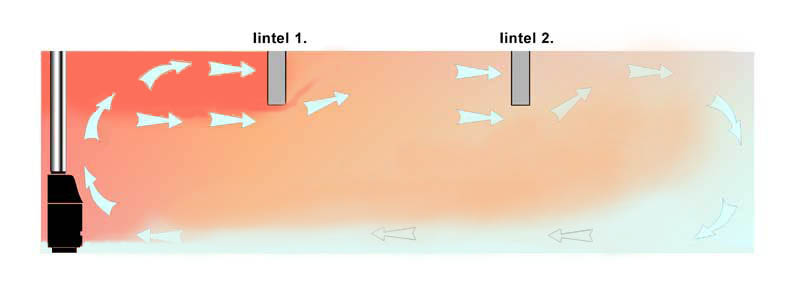Temperature gradients trip everyone up. Nearly every home has a “cold spot” and bigger homes usually have several. What’s worse than paying hefty bills for a heating system only to find yourself suffering perpetual discomfort? This section explains what temperature gradients are and what you can do to temper their effects.
1. Introduction to temperature gradients (a)
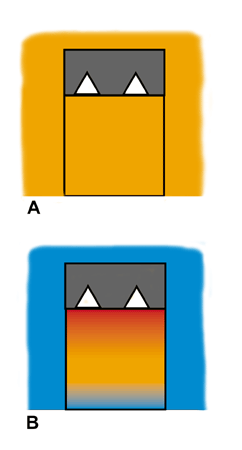
During the summer months, the temperatures inside and outside a house are more or less evenly balanced and constant at all heights (A.)
In winter, the position alters considerably. Our attempts to simulate summer conditions can never be completely successful because of the problem of temperature gradient. Whenever we attempt to heat small enclosed volumes of air against a background of much cooler temperatures, some separating out occurs. The air we have warmed rises up towards the ceiling, while cooler air sinks down to ankle level (B.)
The greater the difference, the greater our discomfort since the “thermostats” in our body don’t know which temperature to respond to and we end up feeling either ‘stuffy’ or suffering from cold feet.
In this situation, turning the heat up may only make things worse as well as increasing our heating bills.
2. Introduction to temperature gradients (b)
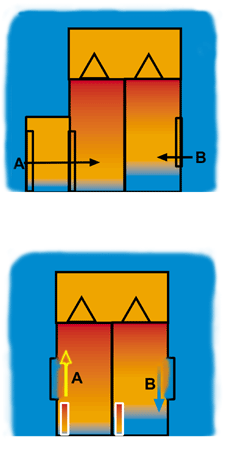
To be successful, you need to attack the uncomfortable effects of temperature gradient on several fronts.
It is easiest to do this by eliminating large differences in air temperature at source. In the top illustration at right, a room that draws its fresh air supply from a heated hallway (A) will exhibit a less extreme gradient than one ventilated simply by opening a window (B). It takes only a small volume of cold air to make a warm room feel uncomfortable, so “draught stripping” (i.e., attending to leaky doors & window frames) should be your first priority.
The lower illustration at right shows how placement of radiator panels has a significant effect on temperature gradient. When a panel is placed directly beneath a window (A.) it re-heats the air that has been chilled by contact with the cold glass and prevents it from sinking.
In (B.) the panel is located against an inner wall and air chilled by the window is now free to sink down to floor level and accumulate to an uncomfortable depth.
3. How heat sources affect temperature gradients
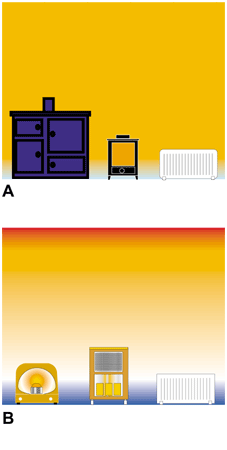
The type of heat source you install can have a big impact on temperature gradient.
Stoves, cookers and panel radiators all have a large exposed warm surface area that transfers a gentle heat to the surrounding air (A.)
Mobile oil and gas heaters have elements that are small and intensely hot. They produce most of their output as radiant heat but also tend to create an extreme temperature gradient because they heat a small volume of air to a very high temperature. This encourages the cold and hot air to separate out into static layers with a thin layer of very hot air sticking close to the ceiling (B.) Cheap electric convector heaters that make use of small, high-temperature elements will produce much the same effect.
4. Temperature gradients and open fires
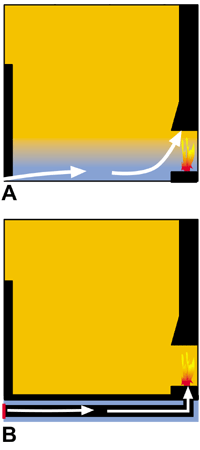
Open fires can be a particular problem because of the large volumes of cold air they have to drag into the room simply to keep going. Since this is drawn in at floor level, it is always cooler than the surrounding air. Furthermore, it’s not just static as in earlier examples but is actually flowing across at ankle level in a continuous stream (A.)
Ducting a supply of fresh air to the fire through an under-floor channel can drastically reduce the problem of temperature gradient and ankle draughts (B.)
Note that the situation described in this frame applies only to open fires and to stoves that are being run with the doors open for prolonged periods. When a stove is run with the doors closed, the amount of air consumed is negligable and highly unlikely to generate any noticable draught.
Building Regulations now require a minimum volume of fresh air to be supplied to any room containing a heating appliance that burns fuel. It generally makes sense to duct the air as close to the appliance as possible.
5. Temperature gradients and stairwells
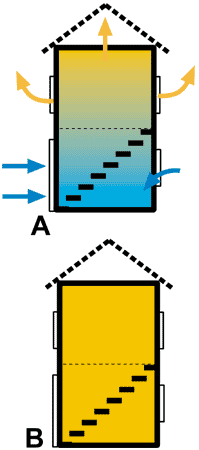
Stairwells are particularly prone to developing a steep temperature gradient because the ceiling height is at least doubled. If draft stripping is poor, conditions are perfect for a ‘chimney draft’ to develop in which warm air at ground level is sucked upwards and lost through leaky upper-floor windows (A.)
The only effective solution to this problem may be to;
- draft-strip
- insulate
- recirculate warm air from the highest point back down to the lowest point. This can be done using one or more fans, possibly contained within a duct.
These measures will help to even-up the temperature (and density differences) between the air at higher and lower levels and make things more comfortable at ground level (B.)
Note; hotels and other commercial establishments are obliged by law to fit a partition and fire door on upper landings. This helps to reduce the temperature gradient within the stairwell and may be worth considering in some domestic situations.
6. Temperature gradients and conservatories
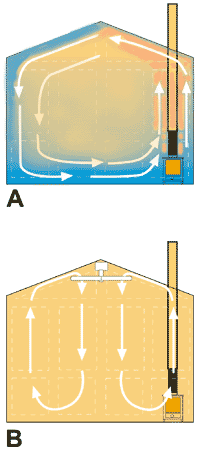
Conservatories and sunlounges are notoriously difficult to heat at night because their properties naturally encourage extreme temperature gradients.
Warm air is chilled quite rapidly by contact with glass on a frosty night – even when the glass is the inner leaf of a double glazing system. And as we have seen earlier, chilled air accumulates at floor level, displacing the warmer, lighter air to a higher level.
Introducing a stove or other heat source into this situation causes the air to start revolving in a ‘cartwheel’ that is alternately heated on one side and cooled on the other (A.) This is not comfortable since you are likely to find yourself sitting in the cross-flow of cold air at the base!
A possible way to alleviate the problem is to stir the air up mechanically with a fan (B.) Many conservatories are equipped with a large diameter ceiling fan or “punka” and if you don’t already have one it may be worth getting one for the comfort it can add during cold winter evenings as well as during the summer. Also fit the best insulating blinds or curtains you can find since anything you can do to reduce heat loss through the glass will add to your comfort while helping to reduce your heating bills.
7. Temperature gradients and long horizontal runs
A common theory is that if you buy a stove with excess capacity for the room it is in, it will ‘waft’ a useful amount of heat right through the house. This can indeed be done where ‘open plan’ architecture has been employed.
The above illustration depicts what happens. A classic ‘cartwheel’ develops in which air heated by the stove is driven up to the ceiling and replaced by cooler, denser air travelling in from the far end of the chamber.
As the ‘cartwheel’ rotates, heat travels further and further out from the stove until it reaches the far wall by which time the warm air has cooled down and increased in density. At this point it sinks down to ground level and is hauled back to the stove.
Over a period of time the temperature gradient diminishes so that the whole area feels comfortably warm, even though density differences are still sufficient to keep the ‘cartwheel’ turning.
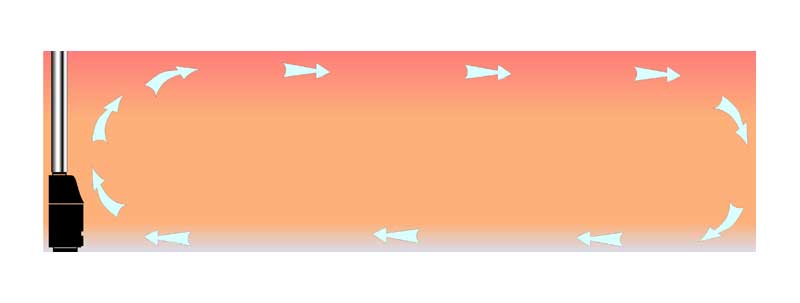
Now look what happens in a typical UK home where the norm is to have several rooms closed off from each other by doors. Unfortunately leaving the doors open between adjacent areas is not the same thing as having open-plan architecture.
Here, the ‘cartwheel’ never develops properly because it keeps meeting a vertical wall above each door. The hottest air therefore gets trapped close to the ceiling directly above the stove and only a small amount bleeds across to adjacent areas. By the time we get to the third room at the right, very little heat is being transferred, so that rotation is slow and spasmodic and the air that does flow back towards the stove at floor level moves sluggishly and remains cold enough to cause considerable discomfort. Indeed, circulation is so poor in this situation that it may never be possible to achieve comfort anywhere other than by closing the door at lintel 1. and reducing the heat output from the stove.
